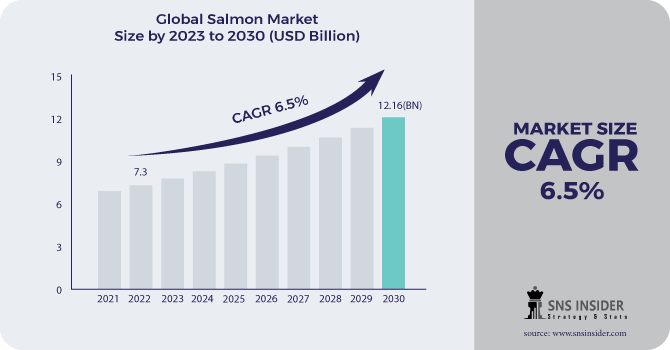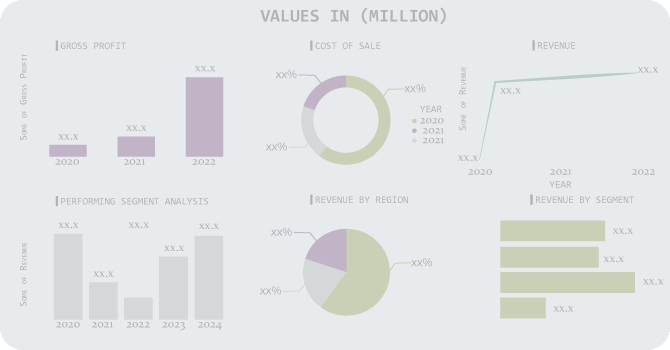Salmon Market Report Scope & Overview:
Salmon Market Size was esteemed at USD 7.3 billion in 2022 and is supposed to arrive at USD 12.16 billion by 2030, and develop at a CAGR of 6.5% over the forecast period 2023-2030.
Salmon is usually characterized as a sleek fish with rich substances of protein and omega-3 unsaturated fats. Most Atlantic salmon accessible in the worldwide market are cultivated, though most Pacific salmon are wild-gotten. Salmon is accessible in various assortments, for example, chinook, coho, pink, red, Salmo salar, and silverbrite. The interest in salmon is quickly expanding universally because of the medical advantages it gives, for example, decreased coronary illness, keeping up with weight file, and development and improvement of bones.

The developing interest for prepared-to-eat salad items combined with the rising notoriety of hot smoked salmon fish is additionally expected to help the market development. The developing acknowledgment of Norwegian natural smoked fish to help the protein and minerals in the eating regimen is driving the market development. In addition, the rising interest in Whole fish in the U.S. also, China is additionally expected to support the market development. The rising interest for salmon fish to get omega-3 unsaturated fats and the solvent Vitamin-D are the central point’s moving the market interest. Be that as it may, the absence of a talented labor force to work hydroponics is frustrating business sector development.
Market Dynamics:
Driving Factors:
-
The developing wellbeing awareness, inactive way of life propensities.
-
Developing stoutness among the populace, and rising discretionary cash flow.
Restraining Factors:
-
Low-input hydroponics overall is outfitted to giving food and broadening pay for the salmon rancher.
Opportunities:
-
The interest in frozen and canned salmon is becoming dramatically because of the rising number of the working populace.
-
The development of prepared-to-eat food items.
Challenges:
-
The disclosure of savagery follows up on animals at animal ranches and slaughterhouses.
-
The development of the veggie lover populace is on the ascent and is supposed to develop altogether all over the planet.
Covid-19 Impact:
The worldwide salmon area has felt the effect of COVID-19 up and down the store network, with creation, handling, and coordinated operations. In Norway, costs were extremely high in Q1, at over NOK 70 for each kilo, and makers have profited from a few long periods of costs, making the area genuinely versatile. In Chile, strategic isolations, curfews, and other COVID-19 limitations have prompted lower volumes of salmonids arriving at handling plants.
Impact of Ukraine-Russia War:
Russia's intrusion of Ukraine has proactively influenced imports of Norwegian salmon. Besides, Europe, the United States, and Japan forced sanctions on Russia to eliminate a few Russian banks from the SWIFT, which will influence Japan's import of Russia's marine items like crabs, salmon, and ocean imps, revealed Minato Shimbun.
Market Estimations:
By Product Type:
In light of Product type, the new section is the biggest fragment. Buying and eating newly gathered is the most ideal way to guarantee no additives, synthetic substances, or colors have been included in the food. Furthermore, new salmon loses its dietary benefit over the long run so it should consume rapidly as additional supplements can be acquired from it.
By Distribution channel type:
By distribution channel, the portion of the retail location was the conspicuous section, attributable to high ubiquity and wide-scale entrance in driving salmon business sectors. Retail locations permit clients to see items including fish. Moreover, agreeable and supportive staff additionally assists with building client steadfastness by offering great quality salmon that makes purchasers visit over and over.
Key Market Segmentation:
By Type:
-
Chinook Salmon
-
Coho Salmon
-
Pink Salmon
-
Red Salmon
-
Salmo Salar
-
Silverbrite Salmon
By End product type:
-
Fresh
-
Frozen
-
Canned
-
Others
By Distribution channel:
-
Retail stores
-
Hypermarket/Supermarket
-
online sales channels
.png)
Regional Analysis:
-
North America
-
USA
-
Canada
-
Mexico
-
-
Europe
-
Germany
-
UK
-
France
-
Italy
-
Spain
-
The Netherlands
-
Rest of Europe
-
-
Asia-Pacific
-
Japan
-
south Korea
-
China
-
India
-
Australia
-
Rest of Asia-Pacific
-
-
The Middle East & Africa
-
Israel
-
UAE
-
South Africa
-
Rest of Middle East & Africa
-
-
Latin America
-
Brazil
-
Argentina
-
Rest of Latin America
-
The interest in the salmon in hardly any European nations, the U.S., and Japan is lessening while the development potential is high in Asia-Pacific and Latin America. The developing interest for salmon in developing business sectors like Asia-Pacific and Latin America is offering rewarding learning experiences to the players working in the worldwide salmon market. Moreover, interest in eco-named cultivated salmon is rising quickly and the inclination for new food items is moving in the salmon market.
Key Players:
Companies covered in Salmon markets are Cremaq Group ASA, Leroy Seafood Group ASA, Mowi ASA, SalMar ASA, Bakkafrost, Greig Seafood, Blumar, Salmones Camanchaca, Nova Sea, Alsaker Fjordbruk, Nordlaks.
Mowi ASA-Company Financial Analysis

| Report Attributes | Details |
|---|---|
| Market Size in 2022 | US$ 7.3 Billion |
| Market Size by 2030 | US$ 12.16 Billion |
| CAGR | CAGR 6.5% From 2023 to 2030 |
| Base Year | 2022 |
| Forecast Period | 2023-2030 |
| Historical Data | 2020-2021 |
| Report Scope & Coverage | Market Size, Segments Analysis, Competitive Landscape, Regional Analysis, DROC & SWOT Analysis, Forecast Outlook |
| Key Segments | • by Type (Chinook Salmon, Coho Salmon, Pink Salmon, Red Salmon, Silverbrite Salmon, and Salmo Salar) • by End Product Type (Fresh, Frozen, Canned, and Others) • by Distribution Channel (Retail Stores, Supermarkets/Hypermarkets, and Online Sales Channels) |
| Regional Analysis/Coverage | North America (USA, Canada, Mexico), Europe (Germany, UK, France, Italy, Spain, Netherlands, Rest of Europe), Asia-Pacific (Japan, South Korea, China, India, Australia, Rest of Asia-Pacific), The Middle East & Africa (Israel, +D11UAE, South Africa, Rest of Middle East & Africa), Latin America (Brazil, Argentina, Rest of Latin America) |
| Company Profiles | Cremaq Group ASA, Leroy Seafood Group ASA, Mowi ASA, SalMar ASA, Bakkafrost, Greig Seafood, Blumar, Salmones Camanchaca, Nova Sea, Alsaker Fjordbruk, Nordlaks. |
| Key Drivers | •The developing wellbeing awareness, inactive way of life propensities. •Developing stoutness among the populace, and rising discretionary cash flow. |
| Market Restraints | •Low-input hydroponics overall is outfitted to giving food and broadening pay for the salmon rancher. |

